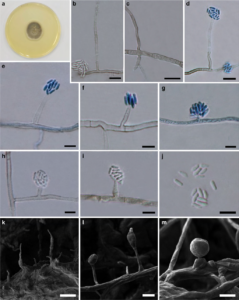Phaeoacremonium tectonaeDoilom & K.D. Hyde, in Ariyawansa et al., Fungal Diversity: 10.1007/s13225-015-0346-5, [141] (2015)
Index Fungorum number: IF551307; Facesoffungi number: FoF: 00880; Fig. 1
Etymology − Name refers to the host genus Tectona on which the fungus was collected.
Holotype − MFLU 15-1392
Associated with heart rot and laurel wilt symptoms of Tectona grandis L.f.. Sexual morph: Undetermined. Asexual morph: Structures on MEA: Mycelium 1–2.5 μm broad, consisting of branched, septate, single or in bundles, partly superficial, partly immersed, hyaline to pale brown, verruculose. Conidiophores (19–) 40–55 (−62) μm long, 1.5–2.7 diam. (x = 41×2 μm), branched in the basal region,arising from aerial or submerged hyphae, erect to slightly curved, up to 3-septate, mostly short, usually unbranched occasionally branched conidiophores, mostly slender, some swollen in the lower part, hyaline to pale brown, gradually paler upwards, smooth to verruculose. Phialides mostly monophialidic, smooth to verruculose; type I and type II phialides most common; type I phialides (1.5–) 3.5–6 (−13) high × (1.3–) 1.7–1.9 (−4) μm (x = 5×1.8 μm), most common, adelophialide, cylindrical, no basal septum; type II phialides (7–) 15–17 (−19) high × (1.5–) 2–2.3 (−3) μm (x = 15×2 μm), predominant, elongate-ampulliform attenuated at the base or subulate, constricted at the base, tapering towards the apex; type III phialides (30–) 48–58 (−62) high × (1.8–) 2.2–2.3 (−2.5) μm (x = 48×2.2 μm), subcylindrical, narrowing gradually to a long neck. Conidia (2–) 3.5–3.7 (−5) high × (0.9–) 1.5–1.7 (−2) μm (x ± S.D. = 3.5±0.5×1.5± 0.4 μm, n=30), hyaline, allantoid to oblong ellipsoidal occasionally
reniform, smooth to verrucose.
Culture characteristics: Pure culturewas isolated by tissue transplanting technique. Colonies on MEA reaching 12–22 and 21–36 mm diam. after 8 and 16 days in the dark at 25 °C respectively (av = 17 and 26 mm for 8 and 16 days respectively n=5), circular, flat, woollen tufts forming on older mycelium plugs, edge entire to undulate; after 8 days, white (3A1) above, in reverse yellowish white (3A2); after 16 days white (4A1) in the centre, greyish brown (6D3) to brownish grey (7E2) at the edge, sometimes colony like vshaped greyish brown (6D3) to brownish grey (7E2) projections above, in reverse greyish brown (6 F3) to yellowish white (4A2) to mixed brownish grey (4E2).
Material examined − THAILAND, Chiang Rai Province, Mae Chan District, on heart rot symptoms of Tectona grandis (Lamiaceae), 23 July 2013, M. Doilom (MFLU 15-1392, holotype: dry culture), ex-type living culture, (MFLUCC 13-0707, MUCL); Chiang Rai Province, Muang District, Mae Khon Subdistrict, on laurel wilt symptom of T. grandis, 23 July 2013, M. Doilom, living culture, (MFLUCC 13- 0708); Chiang Rai Province, Mae Suai District, Mae Lao garden,
on laurel wilt symptoms of T. grandis, 5 July 2014, M. Doilom (living cultures, MFLUCC 13-0708, MFLUCC 14- 1125,MFLUCC 14-1126,MFLUCC 14 1127,MFLUCC 14- 1129, MFLUCC 14-1130, MFLUCC 14-1131).
Notes − Phaeoacremonium was established as a hyphomycete genus by Crous et al. (1996) with Pm. parasiticum as the type species. There are several related genera such as Acremonium, Exophiala and Phialophora. However, a clear classification of Phaeoacremonium and its relatives was provided in Crous et al. (1996) and Mostert et al. (2006). Species of Phaeoacremonium are vascular plant pathogens causing wilting and dieback of several woody plants, moreover species can also cause of human disease (Baddley et al. 2006; Damm et al. 2008; Gramaje et al. 2012). Phaeoacremonium tectonae is introduced here as a new
species based on molecular evidence and morphological features. Phaeoacremonium tectonae (MFLUCC 13-0707, MFLUCC 13-0708, MFLUCC 14-1125, MFLUCC 14- 1126, MFLUCC 14-1127, MFLUCC 14-1129, MFLUCC 14-1130 and MFLUCC 14-1131) grouped near to, but separate from Pm. argentinense L. Mostert et al. CBS 777.83 (sexual morph Togninia argentinensis L. Mostert et al.) with 88%MPBP and 0.99 PP support in the combined actin and β- tubulin phylogeny (Fig. 94). All Phaeoacremonium isolates in this study were from heart rot and laurel wilt symptoms in three locations in Chiang Rai Province, Thailand.
Phaeoacremonium tectonae differs from Pm. argentinense in conidiophores as in Pm. tectonae (19–) 40–55 (−62) av. 41 μm they are longer than in Pm. argentinense (15–) 16–35 (−44) av. 24 μm. Type I and II phialide are the predominant phialide type of Pm. tectonae, while Type II and III are the predominant phialide type of Pm. argentinense.

Fig. 1 Phaeoacremonium tectonae (holotype) a Sixteen-day-old colony on MEA b Conidiophores with mycelia c Conidiophores with branched in the basal region d Conidiophore with conidia, gradually paler upwards e, i Type II phialides with conidia f Type I phialides with conidia and adjacent lateral phialides g Adelophialides with conidia h Type I phialides with conidia j Conidia k Conidiophores l-m. Conidiophores with conidia Notes: d–g in Lactophenol cotton blue. k–
m. photos from Scanning electron microscope (SEM). Scale bars: b–d, k=10 μm, e–j, l, m=5 μm
